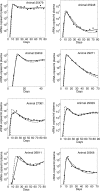Viral dynamics during primary simian immunodeficiency virus infection: effect of time-dependent virus infectivity
- PMID: 20147390
- PMCID: PMC2863724
- DOI: 10.1128/JVI.02284-09
Viral dynamics during primary simian immunodeficiency virus infection: effect of time-dependent virus infectivity
Abstract
A recent experiment involving simian immunodeficiency virus (SIV) infection of macaques revealed that the infectivity of this virus decreased over the first few months of infection. Based on this observation, we introduce a viral dynamic model in which viral infectivity varies over time. The model is fit to viral load data from eight (donor) monkeys infected by intravaginal inoculation of SIVmac251, three monkeys infected by intravenous inoculation of virus isolated from the donors during the ramp-up phase of acute infection, and three monkeys infected by intravenous inoculation of virus isolated at the viral set-point. Although we only analyze data from 14 monkeys, the new model with time-dependent infectivity seems to fit the data significantly better than a widely used model with constant infectivity (P = 2.44 x 10(-11)). Our results indicate that plasma virus infectivity on average decays approximately 8-fold (95% confidence interval [CI] = 5.1 to 10.3) over the course of acute infection, with the decay occurring exponentially with an average rate of 0.28 day(-1) (95% CI = 0.14 to 0.42 day(-1)). The decay rate in set point plasma virus recipient animals is approximately 16 times slower than in ramp-up plasma virus recipient animals and approximately 6 times slower than in donor animals. Throughout acute infection up to the set-point, the infection rate is higher in ramp-up plasma virus recipient animals than in set-point plasma virus recipient animals. These results show that the infectivity depends upon the source of viral infection.
Figures




Similar articles
-
High specific infectivity of plasma virus from the pre-ramp-up and ramp-up stages of acute simian immunodeficiency virus infection.J Virol. 2009 Apr;83(7):3288-97. doi: 10.1128/JVI.02423-08. Epub 2009 Jan 7. J Virol. 2009. PMID: 19129448 Free PMC article.
-
Route of simian immunodeficiency virus inoculation determines the complexity but not the identity of viral variant populations that infect rhesus macaques.J Virol. 2001 Apr;75(8):3753-65. doi: 10.1128/JVI.75.8.3753-3765.2001. J Virol. 2001. PMID: 11264364 Free PMC article.
-
Insights into the Impact of CD8+ Immune Modulation on Human Immunodeficiency Virus Evolutionary Dynamics in Distinct Anatomical Compartments by Using Simian Immunodeficiency Virus-Infected Macaque Models of AIDS Progression.J Virol. 2017 Nov 14;91(23):e01162-17. doi: 10.1128/JVI.01162-17. Print 2017 Dec 1. J Virol. 2017. PMID: 28931681 Free PMC article.
-
Immunodeficiency in the absence of high viral load in pig-tailed macaques infected with Simian immunodeficiency virus SIVsun or SIVlhoest.J Virol. 2005 Nov;79(22):14044-56. doi: 10.1128/JVI.79.22.14044-14056.2005. J Virol. 2005. PMID: 16254339 Free PMC article.
-
Experimental coinfection of rhesus macaques with rhesus cytomegalovirus and simian immunodeficiency virus: pathogenesis.J Virol. 2002 Aug;76(15):7661-71. doi: 10.1128/jvi.76.15.7661-7671.2002. J Virol. 2002. PMID: 12097580 Free PMC article.
Cited by
-
Modelling the effects of phylogeny and body size on within-host pathogen replication and immune response.J R Soc Interface. 2017 Nov;14(136):20170479. doi: 10.1098/rsif.2017.0479. J R Soc Interface. 2017. PMID: 29142017 Free PMC article.
-
A review of mathematical models of influenza A infections within a host or cell culture: lessons learned and challenges ahead.BMC Public Health. 2011 Feb 25;11 Suppl 1(Suppl 1):S7. doi: 10.1186/1471-2458-11-S1-S7. BMC Public Health. 2011. PMID: 21356136 Free PMC article.
-
Early HIV infection predictions: role of viral replication errors.SIAM J Appl Math. 2018;78(4):1863-1890. doi: 10.1137/17M1134019. Epub 2018 Jul 3. SIAM J Appl Math. 2018. PMID: 31231142 Free PMC article.
-
Prevention of HIV-1 transmission with postexposure prophylaxis after inadvertent infected blood transfusion.AIDS. 2014 Jun 19;28(10):1539-41. doi: 10.1097/QAD.0000000000000268. AIDS. 2014. PMID: 24896805 Free PMC article. No abstract available.
-
What drives the US and Peruvian HIV epidemics in men who have sex with men (MSM)?PLoS One. 2012;7(11):e50522. doi: 10.1371/journal.pone.0050522. Epub 2012 Nov 29. PLoS One. 2012. PMID: 23209768 Free PMC article.
References
-
- Alter, H. J., R. Sanchez-Pescador, M. S. Urdea, J. C. Wilber, R. J. Lagier, A. M. Di Bisceglie, J. W. Shih, and P. D. Neuwald. 1995. Evaluation of branched DNA signal amplification for the detection of hepatitis C virus RNA. J. Viral Hepat. 2:121-132. - PubMed
-
- Bates, D. M., and D. G. Watts. 2007. Nonlinear regression analysis and its applications. John Wiley & Sons, Inc., Hoboken, NJ.
-
- Bourinbaiar, A. S. 1994. The ratio of defective HIV-1 particles to replication-competent infectious virions. Acta Virol. 38:59-61. - PubMed
Publication types
MeSH terms
Grants and funding
LinkOut - more resources
Full Text Sources

